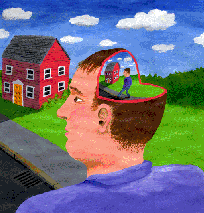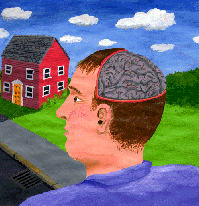
|
← ??? → |

|
| Previous | Return to Steve Lehar | Next |
But the indirect realist solution comes at a cost. In return for resolving the epistemological question, indirect realism opens a new paradox, and that is a glaring disparity between two primary sources of knowledge, phenomenology and neurophysiology. Phenomenology presents the mind as a three-dimensional colored structure or analogical representation, while neurophysiology presents the brain as an assembly of billions of discrete quasi-independent local processors interconnected in a massively parallel network. Where in that mass of neural circuitry are the three-dimensional volumetric real-time moving pictures that we know so well in conscious experience? The brain just seems to be the wrong kind of device to create that kind of representation. Is consciousness therefore an illusion with no direct neurophysiological correlate? Or is there something fundamentally wrong with our understanding of neurophysiology?

|
← ??? → |

|
The information that phenomenal experience gives us about the external world is known to be somewhat uncertain, as we are easily fooled by illusions, and occasionally by outright hallucinations. But when the object of our phenomenological investigation is conscious experience itself, our knowledge of that particular entity is very certain. In fact our knowledge of our own conscious state is more certain and reliable than any other knowledge we can possibly have, even when our conscious experience is itself only a hallucination. Neuroscience on the other hand is a science very much in its infancy, and is rife with uncertainty. In fact the "dirty little secret" of neuroscience, as Searle (1997, p. 198) calls it, is that the central principles of representation and computation in the brain remain to be discovered. Very little is known with any real certainty about how perceptual or cognitive information is encoded in the brain, or what kind of computation the brain actually performs in perception. And there are several prominent aspects of brain activity whose functional significance remains almost entirely obscure, such as the synchronous oscillations observed between neurons in remote cortical areas, and the global oscillations of the brain as a whole as seen in Electroencephalogram (EEG) recordings. The phenomenological inspection of conscious experience therefore offers more reliable and certain knowledge of the essential principles of mental representation and function than anything that modern neuroscience has yet to offer, because it gives us direct access to the massive quantities of information encoded in the brain, presented in a form that is immediately meaningful to us. If our observations of the nature of phenomenal experience are in conflict with contemporary concepts of neurocomputation, it is our neurophysiological theories which are in urgent need of revision in order to bring them in line with observed phenomenologically. For a neuroscience which explains everything about the brain except for how it generates the mind, is a neuroscience which essentially explains nothing, because it is the mind that makes the brain interesting in the first place.
Information theory offers an interesting new angle on the problem. For information cannot exist without some physical medium, or carrier, because the information is encoded as modulations of that carrier. In the brain the carrier is some kind of electrochemical state, and the information encoded in the brain is presumably expressed as modulations of that electrochemical state across space and time. A similar information theoretic organization is observed on the subjective side of the mind / brain barrier. Every point in the three-dimensional matrix of phenomenal space can express every color in the gamut of phenomenal color experience, including the experience of transparency, or of empty space. Conscious experience is expressed in perception as patterned modulations of those color qualia across space and time. Information theory therefore suggests that the qualia, such as the primal experience of color and space, are themselves the carrier, or the mechanism by which experience is represented or expressed in the brain, whereas the spatial and temporal modulations of those basic qualia across the volume of phenomenal space represent the information content of the representation, i.e. the perceptual scene that is being currently portrayed.
For the most part perception is indirect, we view the world through the medium of conscious experience. But there is one, and only one entity that we do see directly, and that is the representational mechanism itself, the inside of our own brain. The volume of space we perceive around us is a data structure in our physical brain, and the primal color qualia with which that world is painted are different states of the physical mechanism of our own physical brain.
| Previous | Return to Steve Lehar | Next |